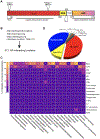Androgen receptor (AR) heterogeneity in prostate cancer and therapy resistance
- PMID: 34118355
- PMCID: PMC8355210
- DOI: 10.1016/j.canlet.2021.06.006
Androgen receptor (AR) heterogeneity in prostate cancer and therapy resistance
Abstract
Androgen receptor (AR), a ligand-dependent nuclear transcription factor and a member of steroid hormone receptor family, plays an important role in prostate organogenesis by regulating epithelial differentiation and restricting cell proliferation. Although rarely mutated or amplified in treatment-naïve prostate cancer (PCa), AR signaling drives tumor growth and as a result, therapies that aim to inhibit AR signaling, called ARSIs (AR signaling inhibitors), have been in clinical use for >70 years. Unfortunately, the clinical efficacy of ARSIs is short-lived and the majority of treated patients develop castration-resistant PCa (CRPC). Numerous molecular mechanisms have been proposed for castration resistance; however, the cellular basis for CRPC emergence has remained obscure. One under-appreciated cellular mechanism for CRPC development is the AR heterogeneity that pre-exists in treatment-naive primary tumors, i.e., although most PCa cells express AR (i.e., AR+), there is always a population of PCa cells that express no/low AR (i.e., AR-/lo). Importantly, this AR heterogeneity becomes accentuated during ARSI treatment and highly prominent in established CRPC. Here, we provide a succinct summary of AR heterogeneity across the PCa continuum and discuss its impact on PCa response to treatments. While AR+ PCa cells/clones exhibit exquisite sensitivities to ARSIs, AR-/lo PCa cells/clones, which are greatly enriched in stem cell signaling pathways, display de novo resistance to ARSIs. Finally, we offer several potential combinatorial strategies, e.g., ARSIs with stem cell targeting therapeutics, to co-target both AR+ and AR-/lo PCa cells and metastatic clones.
Keywords: Androgen receptor; Cancer cell heterogeneity; Cancer stem cells; Castration-resistant prostate cancer; Prostate cancer; Therapy resistance.
Copyright © 2021 The Authors. Published by Elsevier B.V. All rights reserved.
Conflict of interest statement
Declaration of Interest Statement:
The authors declare no conflict of interests.
Figures


References
-
- Tsai MJ, O’Malley BW, molecular mechanisms of action of steroid/thyroid receptor superfamily members, Annu. Rev. Biochem 63 (1994) 451–486. - PubMed
-
- Auwerx J, Baulieu E, Beato M, Becker-Andre M, Burbach PH, Camerino G, et al., A unified nomenclature system for the nuclear receptor superfamily, Cell 97 (1999) 161–163. - PubMed
-
- Centenera M, Harris JM, Tilley WD, Butler LM, The contribution of different androgen receptor domains to receptor dimerization and signaling, Mol. Endocrinol 22 (2008) 2373–2382. - PubMed
-
- van Royen ME, van Cappellen WA, de Vos C, Houtsmuller AB, Trapman J, Stepwise androgen receptor dimerization, J. Cell Sci 125 (2012) 1970–1979. - PubMed
-
- Shang Y, Myers M, Brown M, Formation of the androgen receptor transcription complex, Mol. Cell 9 (2002) 601–610. - PubMed
Publication types
MeSH terms
Substances
Grants and funding
LinkOut - more resources
Full Text Sources
Medical
Research Materials

